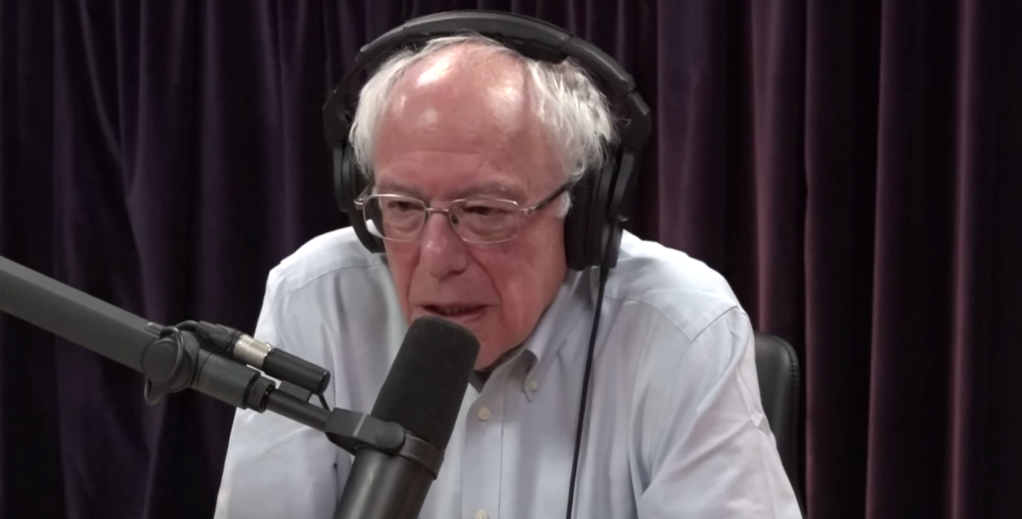Joe Rogan is one of the most influential people in media. That doesn’t mean he’s a good interviewer or a responsible communicator when speaking to a large and devoted audience, but it is a fact. It’s hard to pinpoint the exact size of his podcast’s audience, but Rogan’s official YouTube channel has 7.3 million subscribers and he recently claimed his podcast gets 190 million downloads a month.
When Elon Musk goes on Rogan’s show and smokes a blunt, Tesla stocks take a tumble (though as Rogan notes at every opportunity, they quickly bounced back). It was a big deal when Bernie Sanders sat down with Rogan for an hour-long interview in August, and an even bigger deal earlier this week when Rogan said that he would probably vote for Sanders in the upcoming election. Sanders is not the first presidential candidate to go on Rogan’s podcast—Tulsi Gabbard has been on several times—nor is Sanders the first candidate to get something resembling an endorsement from Rogan. Rogan hosted and voted for Libertarian Gary Johnson in 2016.
Videos by VICE
On Thursday, Sanders tweeted a clip from Rogan’s podcast highlighting his endorsement, in which Rogan said he likes Sanders for career-long consistency in his politics.
Rogan’s endorsement of Sanders is notable because unlike Johnson, Sanders has an actual shot at taking the White House, and in a close race, gaining the support of even a portion of Rogan’s massive, loyal audience could be a difference maker. What’s less clear is why the Sanders campaign embraced and promoted the endorsement, knowing that Rogan is controversial and hated by parts of his base. Rogan’s endorsement is so influential, his audience so large, that it’s not even clear Sanders needed to acknowledge it because Rogan’s audience rivals (and is likely larger than) his own. Who is Sanders reaching with a Joe Rogan video clip that Rogan hasn’t already reached?
Rogan’s endorsement, and the video Sanders shared on Twitter in particular, has caused some controversy among people who argue that Rogan is a bigot who should be marginalized, ignored, or disavowed.
Rogan hasn’t wielded his power with much responsibility: He’s given people like Chuck Johnson, Milo Yiannopoulos, Alex Jones, Stefan Molyneux, and Gavin McInnes access to his gigantic audience, and Rogan rarely challenges his guests on their views, allowing them to launder their bad ideas on his show. Data & Society researcher Becca Lewis has argued that Rogan giving a platform to these people has led his audience down more extremist rabbit holes on YouTube. Lewis describes Rogan as a “libertarian influencer with mainstream appeal.”
“When [Rogan] hosts other members of the Intellectual Dark Web, it’s easy to get drawn into that world,” Lewis told Motherboard in 2018. That Rogan is an entry point to other YouTube and podcast influencers speaks to his own influence; whether Rogan’s endorsement matters doesn’t depend on whether Rogan himself is GOOD or BAD, it’s whether his endorsement moves the needle. And given how much discussion there is about his endorsement and what we know about Rogan’s overall influence, it almost certainly does.
A big part of Rogan’s appeal is that he’s an average Joe. Sitting down with him for an interview is not the same as doing a quick spot on CNN or Fox News. His interviews are long (often more than three hours), meandering, and silly. It gives subjects the chance to speak at length and often put their foot in their mouth. For his listeners, a recommendation from Rogan is like a recommendation from a friend, if your friend was talking to millions of people at once. It has the appearance of raw, emotional authenticity. It is the exact opposite of a measured, calculated endorsement from the
New York Times.
What seems to have made lots of people mad, however, is that Sanders has embraced the endorsement. What’s worth noting is that it’s not clear that Sanders sharing the video is actually going to earn him any more voters. Sanders, of course, has a huge audience, but Sanders’ reach is almost certainly smaller than Rogan’s. Sanders’ clip has 3.2 million views on Twitter. Rogan’s audience fluctuates and it’s notoriously difficult to get reliable podcast statistics (especially if you don’t work for that podcast), but if Rogan’s 190 million downloads per month figure is accurate, we could conservatively estimate that each episode is getting far more than 3.2 million downloads.
This is why it’s impossible to “amplify” Joe Rogan: He has an audience bigger than nearly anyone in the country, and to ignore that he exists and that people like him is to remove yourself from reality. There’s little danger in Sanders tweeting this video and radicalizing people because Rogan’s audience is already huge. But sharing the video and tacitly accepting Rogan’s endorsement feels like an unforced error, or at least a risk Sanders didn’t need to take: He’s opened himself up to criticism from parts of his base who care about social justice, marginalized people, and stand against the people and ideas Rogan has allowed to be laundered on his show, without really standing to gain anything.
“The goal of our campaign is to build a multi-racial, multi-generational movement that is large enough to defeat Donald Trump and the powerful special interests whose greed and corruption is the root cause of the outrageous inequality in America,” the Sanders campaign told Motherboard in a statement. “Sharing a big tent requires including those who do not share every one of our beliefs, while always making clear that we will never compromise our values. The truth is that by standing together in solidarity, we share the values of love and respect that will move us in the direction of a more humane, more equal world.”
More
From VICE
-

-

Savannah Sly, dominatrix and co-founder of sex-worker vote mobilization group, EPA United. -

(Photo by Kevin Winter/Getty Images for AFI)

